A Powerful 70mm Projector
|
Read more
at in70mm.com The 70mm Newsletter |
| Written by: Grigorij Shandorovich. English translation by Alex Asp, London | Date: 05.05.2009. Updated 13.11.2010 |
 Hello, Mr Thomas. Hello, Mr Thomas.Send you portion of our 70/35 Russian (Soviet) technology. While we solve the problem of communication, I want to send these 3 images to you of the most POWERFUL cinema machine in the world, the KP-50. Engineered in the USSR. It had an effect of 50.000 Lumen in 70mm mode. On photo 2 and 3 I show you the last surviving copies if the KP-50. It was installed in the Kremlin palace. They were moved to a storage facility during summer 2008. С уважением, Grigorij Shandorovich |
More
in 70mm reading: Czech Republic 35/70mm projectors 70mm Film Projectors Soviet Circular Panorama Советская Кругорама Sovscope 70 Foreign 70mm Films in Russia Soviet 70mm Films in Russia Internet link: |
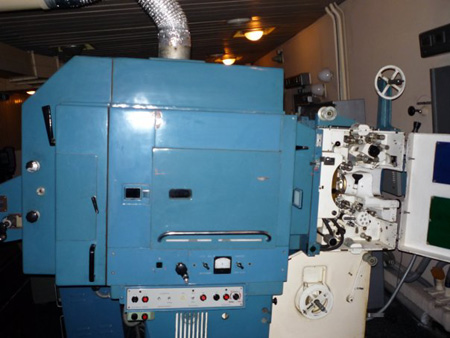 1. KP-30
30.000 lumen with carbon arc lamphouse (200 ampere). A true workhorse, just
like DP-70. This machine was commonly installed in Moscow's, St.
Petersburg's and other big cities of the former USSR in purpose- built 70 mm
cinemas. The machine is 10 on the 1-10 scale. 1. KP-30
30.000 lumen with carbon arc lamphouse (200 ampere). A true workhorse, just
like DP-70. This machine was commonly installed in Moscow's, St.
Petersburg's and other big cities of the former USSR in purpose- built 70 mm
cinemas. The machine is 10 on the 1-10 scale.This machine was replaced by KPK30 model which used Xenon lamps and a different lamphouse. While using 10Kw water-cooled Xenon lamp, the machine delivered 30.000 lumen just as its predecessor. These machines are still in use in many theaters across former USSR. For example they are still working in a 6 theater multiplex in the city of Ufa, albeit only in 35 mm mode. |
|
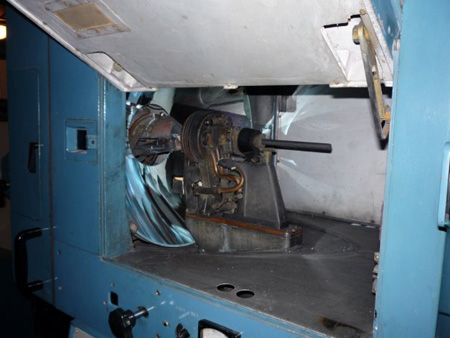 2. KP-15 (originally with carbon arc lamphouse) and KPK-15 delivered 16.000
lumen. KPK-15 used water-cooled 5Kv Xenon lamp. KP-15 machines were slightly
smaller in length thank KP30 models due to a smaller lamphouse. 2. KP-15 (originally with carbon arc lamphouse) and KPK-15 delivered 16.000
lumen. KPK-15 used water-cooled 5Kv Xenon lamp. KP-15 machines were slightly
smaller in length thank KP30 models due to a smaller lamphouse.ALL KP line worked with both 35 and 70mm film and was manufactured by KINAP factory in Odessa (Ukraine). Production cycle 1958-1983. There was a prototype of another 70/35 machine based on 35mm line KSA series known as XENON. The machine was called Xenon 5U, but it never went into mass production. I think I might find a picture of it somewhere. |
|
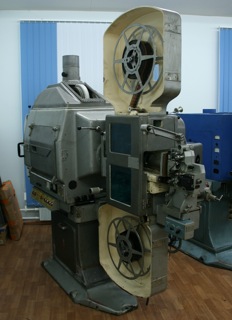 There were only 6 pieces manufactured of KP-50 with carbon arc lamphouse
(300 amp) for the Kremlin Palace of Congresses. The machine was designed
for extra big screens and theaters. As with Xenon 5U KP-50 never went
into mass production although it went beyond the prototype stage. There were only 6 pieces manufactured of KP-50 with carbon arc lamphouse
(300 amp) for the Kremlin Palace of Congresses. The machine was designed
for extra big screens and theaters. As with Xenon 5U KP-50 never went
into mass production although it went beyond the prototype stage.The Russian 5 and 10 Kw water-cooled Xenon lamps are not produced anymore, so existing installations use OSRAM and OSHIO lamps up to 7 Kv in both vertical and horizontal configurations. In the former USSR there were more than 800 purposely built 70 mm movie theaters. More 70 mm installations were used in big Cultural Houses across the country. At present this whole cinema system is in ruins and all that is remains is a miserable reminder. Considering that typical installation contained 3 to 4 machines, one can estimate that there were more than 3500 units produced. | |
Specifications | |
 The
specs for all KP line is as follows: The
specs for all KP line is as follows:Film 35 and 70 mm. Lens holder for one projection lens. Remote framing and focusing is possible. Film speed: 24 fps only. Magnetic sound: 4 channels (35 mm) and 6 channels (70 mm) combined sound head. As of 1965 only 6 channels soundhead Optical sound: mono , inverse reading (35 mm) Shutter: conic, single blade (48 rps) Lamphouse: Carbon-arc, water-cooled fully automatic. Xenon lamphouse in KPK30 DC 150 amp, 200 amp and 300 amp (depending on the model) Light power: depending on the model 15.000, 30.000 or 50.000 lumen with 70 mm aperture and no film in the film gate . Film Spools: 900 m (35 mm) and 1000 m (70 mm) Possible change-over, curtain operation and house lights operation automation with external AKP-6 device. Weight: 850 Kg (KP15), 1000 Kg (KP30), 1250 Kg (KP50) | |
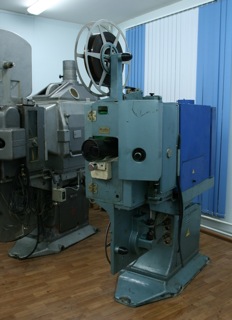 There
is KP30-V with super-intensity water-cooled fully automated arc lamp working
at 200 amp, and creating 30.000 lumens while projecting 70 mm film. There
is KP30-V with super-intensity water-cooled fully automated arc lamp working
at 200 amp, and creating 30.000 lumens while projecting 70 mm film.The machine is capable of reproducing 4 and 6 channels mag sound of 35 and 70 mm prints as well as optical mono sound of 35 mm prints. The machine shown here has 16mm projection adaptor attached to it. The finish is silver, pretty similar to the one used in DP-70. KPK30 is the smaller machine with blue finish The KP30 machine is the one modelled on the DP-70 which Michael Todd brought to Moscow together with TODD-AO camera when he proposed a co-production of "War and Peace" to the soviet ministry of culture in 1957. The proposal was rejected, however, but the equipment stayed in the USSR, and was used in development of Sovscope 70 line of products. | |
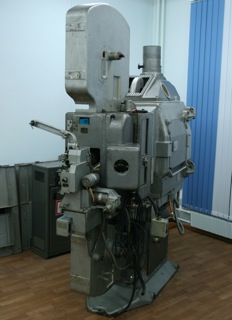 The KP line consisted of KP30A/B/V(c), KP-15 and KP50. Later KPK30 with
xenon lamps superseded the KP30 and KP15 models. More than 3000 units were
manufactured for the entire line, but KP50. The KP50 were almost hand made
and no more than 20 units were manufactured. Five KP50 machines were
installed in the projection room of the Kremlin Palace of Congresses. They
have been removed about a year ago and stored elsewhere. The KP line consisted of KP30A/B/V(c), KP-15 and KP50. Later KPK30 with
xenon lamps superseded the KP30 and KP15 models. More than 3000 units were
manufactured for the entire line, but KP50. The KP50 were almost hand made
and no more than 20 units were manufactured. Five KP50 machines were
installed in the projection room of the Kremlin Palace of Congresses. They
have been removed about a year ago and stored elsewhere.All machines used the same projection head, and differed only in lamp houses which worked at nominal 150, 180, and 200 amp, and delivered 16.000, 30.000, and 50.000 lumen respectively for 70 mm projection. KPK30 projectors could use 5 to 15 Kw Xenon lamps with air and water cooling, delivering comparable amount of light. All those machines where manufactured by KINAP factory in Odessa (Ukraine). | |
|
Go: back
- top - back issues
- news index Updated 22-01-25 |
|
